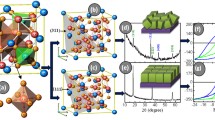Abstract
A new and general spin coating-co-reduction strategy for synthesis of c-axis oriented (Bi,Sb)2(Te,Se)3 chalcogenide thin films and multi-layered structures on different substrates was reported. This method combines spin coating technique and co-reduction chemical reaction processes using commercial nitrates and oxides as raw materials. This simple and reliable method provides a new approach for fabricating chalcogenide semiconductor or semi-metal thin films, and will have wide application potential in opto-electric, thermoelectric, phase-change memory, chemical sensor, and spintronic devices.
Similar content being viewed by others
References
Xu R., Husmann A., Rosenbaum T.F., Saboungi M.L., Enderby J.E., and Littlewood P.B., Large magnetoresistance in non-magnetic silver chalcogenides, Nature 1997, 390: 57.
Thornburg, D.D., Memory switching in a type I amorphous chalcogenide, J. Electron. Mater. 1973, 2: 3.
Nakayama K., Kitagawa T., Ohmura M., and Masakuni S., Nonvolatile memory based on phase transition in chalcogenide thin film. Jpn. J. Appl. Phys., 1993, 32: 564.
Stocker H.J., Bulk and thin film switching and memory effects in semiconducting chalcogenide glasses, Appl. Phys. Lett., 1969, 15: 55.
Kyratsi T., Chrissafis K., Wachter J., Paraskevopoulos K.M., and Kanatzidis M.G., KSb5S8: A wide bandgap phase-change material for ultra high density rewritable information storage, Adv. Mater., 2003, 15: 1428.
Mane R.S., and Lokhande C.D., Chemical deposition method for metal chalcogenide thin films, Mater. Chem. Phys., 2000, 65: 1.
Hsu K.F., Loo S., Guo F., Chen W., Dyck J.S., Uher C., Hogan T., Polychroniadis E.K., and Kanatzidis M.G., Cubic AgPbmSbTe2+m: Bulk thermoelectric materials with high figure of merit, Science, 2004, 303: 818.
Owen A.E., Firth A.P., and Ewen P.J.S., Photo-induced structural and physico-chemical changes in amorphous chalcogenide semiconductors, Phil. Mag. B, 1985, 52: 347.
Fan Z., Razavi H., Do J., Moriwaki A., Ergen O., Chueh Y., Leu P.W., Ho J.C., Takahashi T., Reichertz L.A., Neale S., Yu K., Wu M., Ager J.W., and Javey A., Three-dimensional nanopillar-array photovoltaics on low-cost and flexible substrates, Nat. Mater., 2009, 8: 648.
Zogg H., Fach A., Maissen C., Masek J., and Blunier S., Photovoltaic lead-chalcogenide on silicon infrared sensor arrays, Opt. Eng., 1994, 33: 1440.
Shah A., Torres P., Tscharner R., Wyrsch N., and Keppner H., Photovoltaic technology: The case for thin-film solar cells, Science, 1999, 285: 692.
Mourzina Y.G., Schubert J., Zander W., Legin A., Vlsov Y.G., Lüth H., and Schöning M.J., Development of multisensor systems based on chalcogenide thin film chemical sensors for the simultaneous multicomponent analysis of metal ions in complex solutions, Electrochimica Acta, 2001, 47: 251.
Yamada N., Ohno E., Nishiuchi K., Akahira N., and Takao M., Rapid-phase transitions of GeTe-Sb2Te3 pseudobinary amorphous thin films for an optical disk memory, J. Appl. Phys., 1991, 69: 2849.
Venkatasubramanian R., Colpitts T., O’Quinn B., Liu S., El-Masry N., and Lamvik M., Low-temperature organometallic epitaxy and its application to superlattice structures in thermoelectrics, Appl. Phys. Lett., 1999, 75: 1104.
Venkatasubramanian R., Siivola E., Colpitts T., and O’Quinn B., Thin-film thermoelectric devices with high room-temperature figures of merit, Nature, 2001, 413: 597.
Harman T.C., Taylor P.J., Walsh M.P., and LaForge B.E., Quantum dot superlattice thermoelectric materials and devices, Science, 2002, 297: 2229.
Harman T.C., Taylor P.J., and Walsh M.P., Thermoelectric quantum-dot superlattices with high ZT, J. Electron. Mater., 2000, 29: L1.
Colletti L.P., Flowers B.H., and Stickney J.L., Formation of thin films of CdTe, CdSe, and CdS by electrochemical atomic layer epitaxy, J. Electronchem. Soc., 1998, 145: 1442.
Dimitrakopoulos C.D., and Mascaro D.J., Organic thin-film transistors: A review of recent advances, IBM J. Res. Dev., 2001, 45: 11.
Cui H., Liu H., Li X., Wang J., Han F., Zhang X., and Boughton R.I., Synthesis of Bi2Se3 thermoelectric nanosheets and nanotubes through hydrothermal co-reduction method, J. Solid State Chem., 2004, 177: 4001.
Liu H., Cui H., Han F., Li X., Wang J., and Boughton R.I., Growth of Bi2Se3 nanobelts synthesized through a Co-reduction method under ultrasonic irradiation at room temperature, Cryst. Growth Des., 2005, 5: 1711.
Lankhorst M.H.R., Ketelaars B.W.S.M.M., and Wolters R.A.M., Low-cost and nanoscale non-volatile memory concept for future silicon chips, Nat. Mater., 2005, 4: 347.
Ozaki T., Araki M., Yoshimura S., Koyama H., and Koshida N., Photoelectronic properties of porous silicon, J. Appl. Phys., 1994, 76: 1986.
McConnell H.M., Owicki J.C., Parce J.W., Miller D.L., Baxter G.T., Wada H.G., and Pitchford S., The cytosensor microphysiometer biological applications of silicon technology, Science, 1992, 257: 1906.
Min G., and Rowe D.M., Cooling performance of integrated thermoelectric microcooler, Solid State Electron., 1999, 43: 923.
Dean J.A., Lange’s Handbook of Chemistry, 15th ed., McGraw-Hill, London 1999.
Bart J.C.J., Bossi A., Perissinoto P., Castellan A., and Giordano N., Some observations on the thermochemistry of telluric acid, J. Therm. Anal. Calorim., 1975, 8: 313.
Kolobov A.V., Fons P., Frenkel A.I., Ankudinov A.L., Tominaga J., and Uruga T., Understanding the phase-change mechanism of rewritable optical media, Nat. Mater., 2004, 3: 703.
Boyer A., and Cisse E., Properties of thin film thermoelectric materials application to sensors using the Seebeck effect, Mat. Sci. Eng. B: Solid, 1992, 13: 103.
Author information
Authors and Affiliations
Corresponding author
Rights and permissions
About this article
Cite this article
Zhao, Y., Liu, H., Qin, H. et al. Spin coating-Co-reduction approach: A general strategy for preparation of oriented chalcogenide thin film on arbitrary substrates. Rare Metals 30 (Suppl 1), 651–656 (2011). https://doi.org/10.1007/s12598-011-0365-z
Received:
Revised:
Accepted:
Published:
Issue Date:
DOI: https://doi.org/10.1007/s12598-011-0365-z




